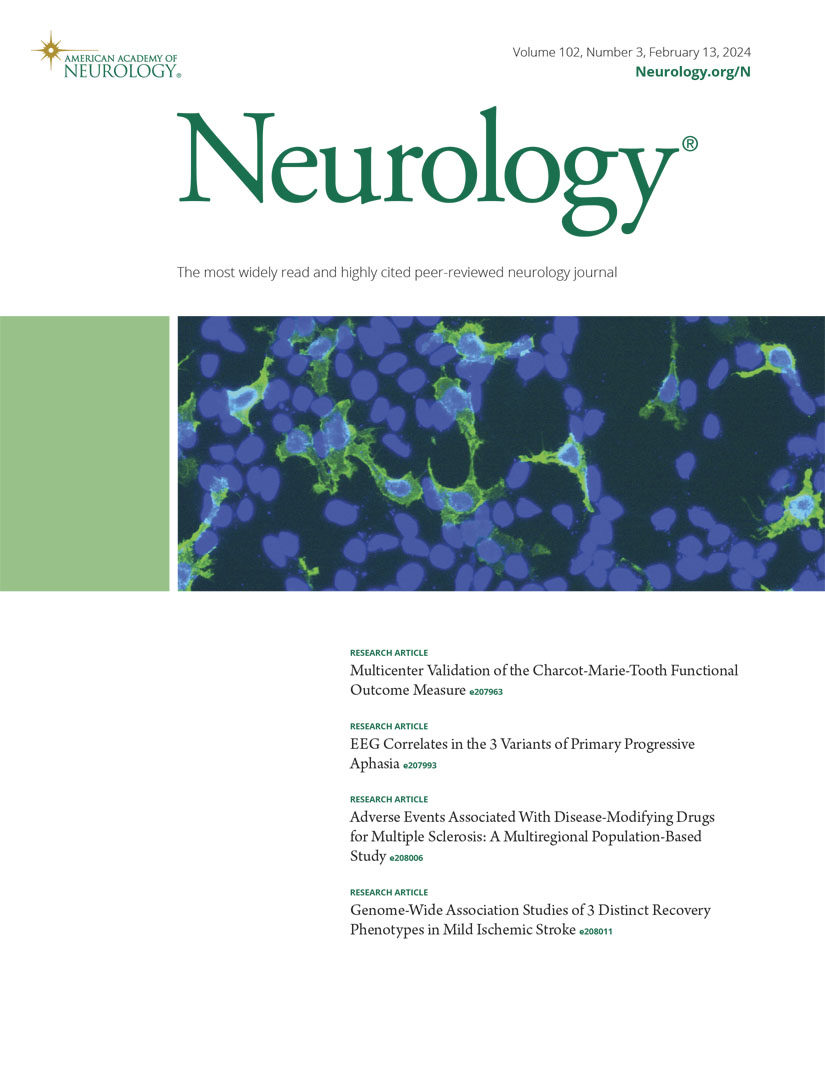迟发性多发性硬化症患者疾病改善疗法的应用
IF 7.7
1区 医学
Q1 CLINICAL NEUROLOGY
引用次数: 0
摘要
背景与目的迟发性多发性硬化症(LOMS)患者的治疗策略仍不明确。在这项研究中,我们旨在评估两组治疗或未治疗的复发缓解型LOMS患者的临床和MRI结果。方法纳入复发缓解型MS患者,如果疾病在55年后发作,并且他们至少有一次随访,则进行分析。主要观察指标是两组匹配的LOMS患者(已治疗和未治疗)首次复发的时间。次要结局如下:(1)首次确认残疾进展(CDP)的时间,(2)独立于复发活动(PIRA)事件的首次进展时间,(3)继发性进展(SPMS)的时间,(4)首次MRI活动的时间,(5)严重感染发生率(IIRs)。对于比较分析,我们采用了时间依赖的倾向得分匹配方法。结果881例患者符合纳入标准。平均发病年龄(SD)为59.9(4.43)岁。应用倾向评分匹配后,匹配436例患者。治疗组的平均(SD)随访时间为5.2(4.27)年,未治疗组为5.0(3.86)年。治疗组到首次复发的平均(SD)时间明显长于未治疗组(7.0年[0.33]vs 5.4年[0.33];P = 0.001)。治疗组到首次MRI活动的平均(SD)时间明显更长(5.9年[0.33]vs 5.0年[0.33]);P = 0.049)。然而,两组患者到CDP、PIRA或SPMS的平均时间没有差异(差异= 0.32年;p = 0.585;差异= 0.40年;PIRA p = 0.442;差异= -0.02年;SPMS p = 0.952)。与治疗组相比,未治疗组的严重iir发生率为0.38 (95% CI 0.07-2.10, p = 0.265),未治疗组的严重iir发生率未增加。本研究表明,疾病修饰治疗(DMT)对LOMS患者的疾病活动性有有益作用,但对残疾进展没有显著影响。主要的限制与数据收集的挑战和两组之间的基线不平衡有关。证据分类:该研究提供了III级证据,证明在LOMS患者中,与未接受DMTs治疗的患者相比,接受DMTs治疗与更长的首次复发时间相关。本文章由计算机程序翻译,如有差异,请以英文原文为准。
Use of Disease-Modifying Therapies in Patients With Late-Onset Multiple Sclerosis.
BACKGROUND AND OBJECTIVES
The therapeutic strategy in patients with late-onset MS (LOMS) remains poorly defined. In this study, we aimed to evaluate both clinical and MRI outcomes between 2 cohorts of patients with relapsing-remitting LOMS treated or not yet treated.
METHODS
Patients with relapsing-remitting MS were included for the analysis if disease onset occurred after 55 years and if they had at least one follow-up visit. The primary outcome was time to first relapse between 2 matched groups of patients with LOMS (treated and not yet treated). Secondary outcomes were as follows: (1) time to first confirmed disability progression (CDP), (2) time to first progression independent of relapse activity (PIRA) event, (3) time to secondary progression (SPMS), (4) time to first MRI activity, and (5) serious infection incidence rates (IIRs). For the comparative analyses, we adopted a time-dependent propensity score matching approach.
RESULTS
A total of 881 patients fulfilled the inclusion criteria. The mean (SD) age at onset was 59.9 (4.43) years. After applying propensity score matching, 436 patients were matched. The mean (SD) follow-up duration was 5.2 (4.27) years in the treated group and 5.0 (3.86) years in the not-yet-treated group. Mean (SD) time to first relapse was significantly longer in the treated group compared with the not-yet-treated group (7.0 years [0.33] vs 5.4 years [0.33]; p = 0.001). Mean (SD) time to first MRI activity was significantly longer in the treated group (5.9 years [0.33] vs 5.0 years [0.33]; p = 0.049). However, the mean time to CDP, PIRA, or SPMS was not different between the 2 groups (difference = 0.32 years; p = 0.585 for CDP; difference = 0.40 years; p = 0.442 for PIRA; difference = -0.02 years; p = 0.952 for SPMS). No increase in serious IIRs was observed with an incidence rate ratio of 0.38 (95% CI 0.07-2.10, p = 0.265) in the never-treated group compared with the treated one.
DISCUSSION
This study demonstrates a beneficial effect of disease-modifying therapy (DMT) on disease activity in patients with LOMS but without significant impact on disability progression. Main limitations are linked to the challenge of data collection and to the baseline imbalances between the 2 groups.
CLASSIFICATION OF EVIDENCE
This study provides Class III evidence that in patients with LOMS, treatment with DMTs is associated with a longer time to first relapse compared with those not treated with DMTs.
求助全文
通过发布文献求助,成功后即可免费获取论文全文。
去求助
来源期刊

Neurology
医学-临床神经学
CiteScore
12.20
自引率
4.00%
发文量
1973
审稿时长
2-3 weeks
期刊介绍:
Neurology, the official journal of the American Academy of Neurology, aspires to be the premier peer-reviewed journal for clinical neurology research. Its mission is to publish exceptional peer-reviewed original research articles, editorials, and reviews to improve patient care, education, clinical research, and professionalism in neurology.
As the leading clinical neurology journal worldwide, Neurology targets physicians specializing in nervous system diseases and conditions. It aims to advance the field by presenting new basic and clinical research that influences neurological practice. The journal is a leading source of cutting-edge, peer-reviewed information for the neurology community worldwide. Editorial content includes Research, Clinical/Scientific Notes, Views, Historical Neurology, NeuroImages, Humanities, Letters, and position papers from the American Academy of Neurology. The online version is considered the definitive version, encompassing all available content.
Neurology is indexed in prestigious databases such as MEDLINE/PubMed, Embase, Scopus, Biological Abstracts®, PsycINFO®, Current Contents®, Web of Science®, CrossRef, and Google Scholar.
 求助内容:
求助内容: 应助结果提醒方式:
应助结果提醒方式:


